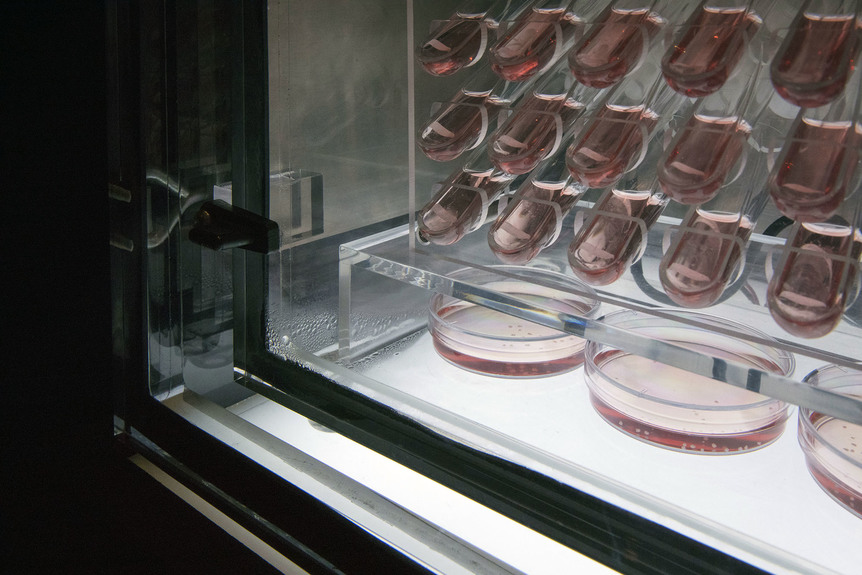-
From Current Issue
-
- Editor’s Letter Fire in the Heart
- Reviews I Gusti Ayu Kadek Murniasih
- Reviews 11th Seoul Mediacity Biennale: “One Escape at a Time”
- Dispatch Networked China
- One on One Monira Al Qadiri on Yukio Mishima
- Essays The rise of independent art spaces in pandemic-era Shanghai
- Features Tuan Andrew Nguyen
- Table of Contents
- Web Exclusives
- Archive
- Subscribe

R
E
V N
E
X
T
Installation view of SEAN RAPSET’s solo exhibition “New Molecules & Stem Cell Retinoid Screen,” at Empty Gallery, Hong Kong, 2019. All photos by Michael Yu; courtesy the artist and Empty Gallery.
“New Molecules & Stem Cell Retinoid Screen,” the title of American artist Sean Raspet’s first solo exhibition in Hong Kong, was as literal a description as one could expect. The exhibition was divided into two sections dedicated respectively to the two chemical substances mentioned—no more and no less. These featured works are all products of Raspet’s industrial collaborations, and form part of his ongoing research into the infinite potential of creation and experimentation at a fundamental, molecular level. In this context, the exhibition resembled the artist’s sparse personal laboratory, placing the viewers as test subjects of his prototypes.
The upper level of Empty Gallery’s space presented three synthetic fragrances devised jointly by Raspet and chemist Shenping Zheng: Fructaplex© (2018–19), Sylvoxime© (2019), and Hyperflor© (2018–19). Each scent was formulated from a newly-developed molecule Raspet alleges to be currently unavailable in the natural and industrial climate. Dispersed individually via inconspicuous diffusers mounted onto opposite ends of adjacently partitioned rooms, the gallery envisioned an immersive experience in which each discrete area would be saturated in a unique scent. However, this concept fell short in reality as one had to hover extremely close to the machines to detect any distinct fragrance, possibly due to the rooms being too large or the circulation of vapor molecules inadequate. Even so, Raspet’s decision to subvert the conventional authority of sight in favor of the olfactory is refreshing, and visitors who stayed near the machines were rewarded with new experiences: Fructaplex© carries saccharine notes while Sylvoxime© evokes the image of a pastoral countryside; Hyperflor© smells like a mix between fresh blooms and musty vegetation.
It was interesting to learn from the exhibition’s press release that Raspet had obtained patents for these creations, with plans to assimilate them into mass production processes of fragrance-encompassing consumables such as laundry detergent and perfume. This procedure is paradigmatic of Raspet’s artistic practice; his works aim to redefine the functionality of art beyond aesthetic considerations and expand their implications on the commodity market. Nonfood, a nutrition company he founded with writer and researcher Lucy Chinen in 2016, serves as both a commercial product and artwork promoting algae-based food alternatives as a sustainable food option. Art for Raspet is thus accessible and practical, not exclusive and esoteric. By seeking ways for his works to continuously exist in different forms relevant to a large demographic, Raspet attempts to rekindle a utilitarian approach to art adopted by artists associated with the Russian Constructivist and Productivist movements of the early 20th century.
Installation view of SEAN RASPET’s Screen (EP1.1 iPSCs stem cell line-derived human retinal organoids), 2018–19, produced in collaboration with Kiara Eldred, induced pluripotency episomal-derived EP1.1 iPSCs human stem-cells developed into functioning retinal organoids via small molecule signalling, 6 × 6 resolution, incubator designed by Joseph Stewart, dimensions variable, at "New Molecules & Stem Cell Retinoid Screen,” Empty Gallery, Hong Kong, 2019.
On the lower floor, a single standing sculpture of a glowing transparent cube, resembling an incubator, illuminated the dark interior. Enclosed within is a matrix of test tubes situated above a row of three identical petri dishes, all partially filled with a mysterious orangey-red liquid containing gray specks. Screen (EP1.1 iPSCs stem cell line-derived human retinal organoids) (2018–19) is a collaborative study with Johns Hopkins University’s scientist, Kiara Eldred, on human stem cells which have been reprogrammed from a pluripotent state into developing retinal cells. Connected to a tank supplying medical-grade carbon dioxide, these cells will allegedly be able to receive optical stimuli from their surroundings when they mature. According to Raspet, the cells can then “see” exhibition visitors watching them, thereby challenging the accepted passivity of the art object and hierarchy of viewership.
While Screen seems futuristic in ambition and slightly far-fetched in its claims at present, Raspet’s works in general embody the investigative spirit and imaginative possibilities of a coalition between the arts, science, and wider economy. “New Molecules & Stem Cell Retinoid Screen” is heavily rooted in scientific language and theories. Yet, even if one were impervious to the chemistry and technicality of his works, it makes for an interesting phenomenological visit, perhaps more so if Raspet could demonstrate how they evolve with time and adaptation. Just imagine: what was once mere stem cells in test tubes might one day return your gaze.
Evelyn Goh is an editorial intern of ArtAsiaPacific.
Sean Raspet’s “New Molecules & Stem Retinoid Screen” is on view at Empty Gallery, Hong Kong, until September 7, 2019.
To read more of ArtAsiaPacific’s articles, visit our Digital Library.


















